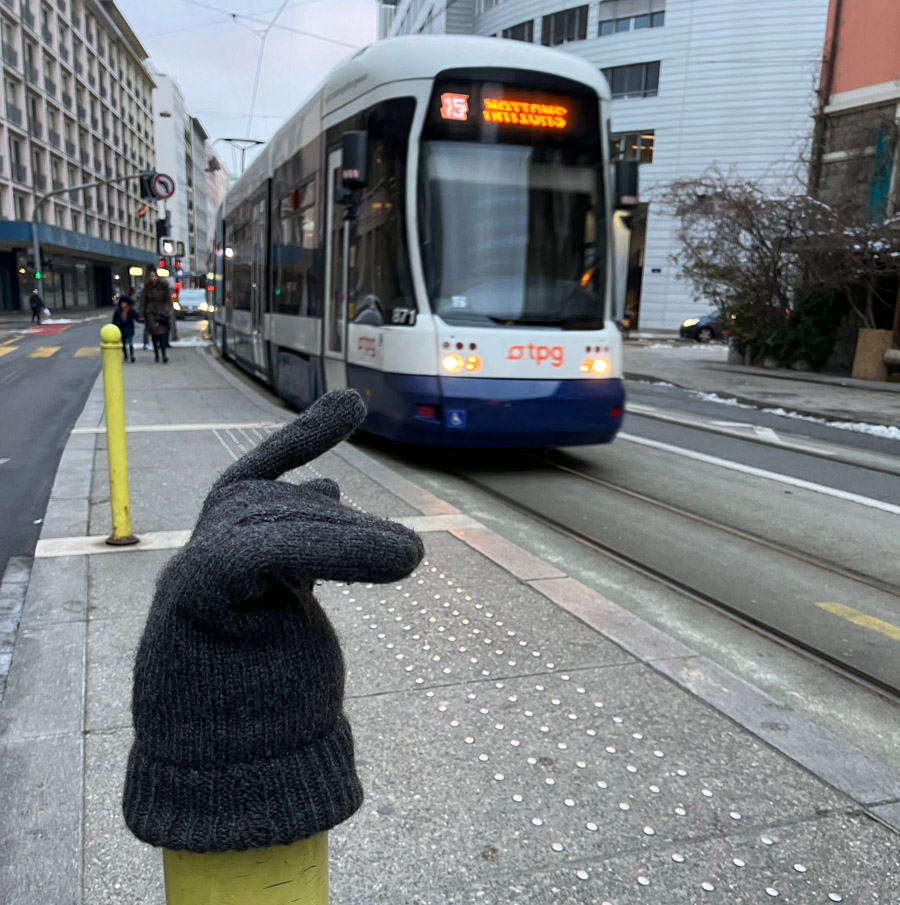One of the mildly endearing traits of a Midwest winter is the January thaw — an oddly reliable statistical anomaly in which the staggered accumulation of several snowfalls momentarily reverses itself, teasing us with a head fake toward a still-distant spring. As icy sidewalks grudgingly clear, and the grimy layers of once-proud snowpiles collapse into mush and slush, anything that cannot rejoin the watershed is left conspicuously behind, untidy and out of place, as if a glacier had receded.
Now is when a season of coping and frustration first takes account of itself, in a lively expository dialogue that breaks out among the till and the drift. Broken auto parts litter the curbsides, fallen twigs and branches taunt the groundskeeper, and winter items such as hats and wrong-handed gloves loiter at park benches and bus stops, having permanently missed their connection.
Soon, many of these items will be silenced by another snowfall, and perhaps another, before they are finally disgorged for good, the memory of their lost utility ground down into irrelevance, in the gathering warmth of spring.
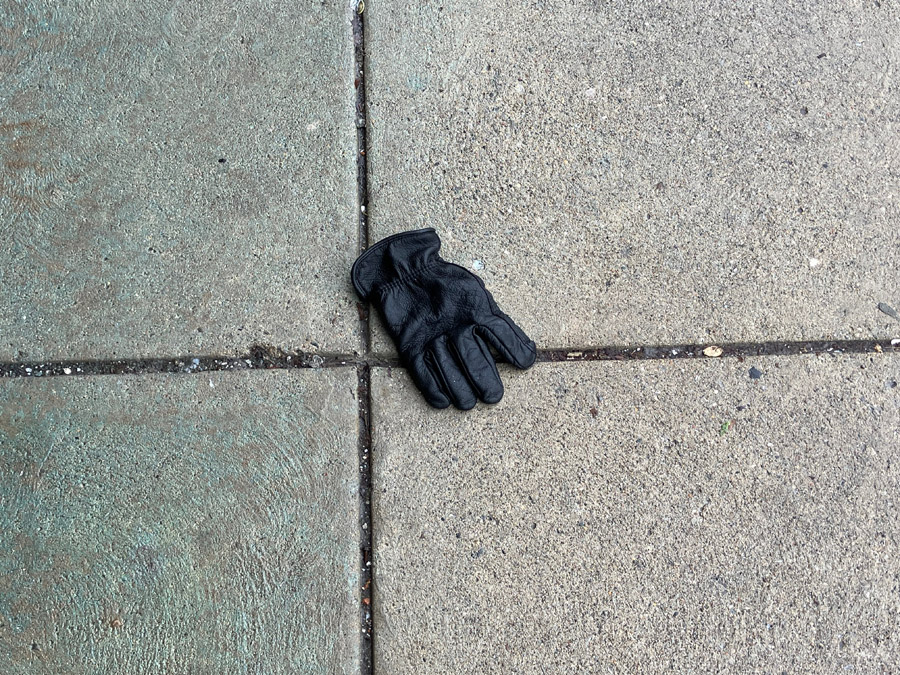
Losing and finding
Of the various things that become entrained in a winter’s passage, it is the lost items that carry the most intrigue. We all can identify with the mild stress that accompanies our stepping in or out of doors, as we hastily reconfigure to address a change of fifty degrees or more. It can only add to that stress to discover, perhaps a bit later, that a glove or a hat has somewhere declined to follow. The transitional zones of storefront doors, bus stops, and streetside parking spots are probably where we most often leave these parts of ourselves behind — for another, perhaps, to find.
In fact, it is the act of losing that creates the possibility of finding, and many a lost item will one day realize its latent duality with the found. Although the term “lost and found” may seem a bit paradoxical (how can something be both lost and found at the same time?), the items in a lost-and-found department are indeed both — lost by one, and found by another. Thus they each embody a virtual connection between two strangers, who likely will never meet.
More interestingly, this connection arises from an impulse that seems somewhat out of place in a population that seems largely preoccupied with avoiding itself. Confronted unexpectedly with the plight of a lost item, there are three possible reactions: ignore it, keep it, or try to reunite it with its owner. Most people will simply pass it by, especially if it has little value. But in others, it arouses a mild flash of empathy — enough to motivate a spontaneous impulse to assist its rightful return.
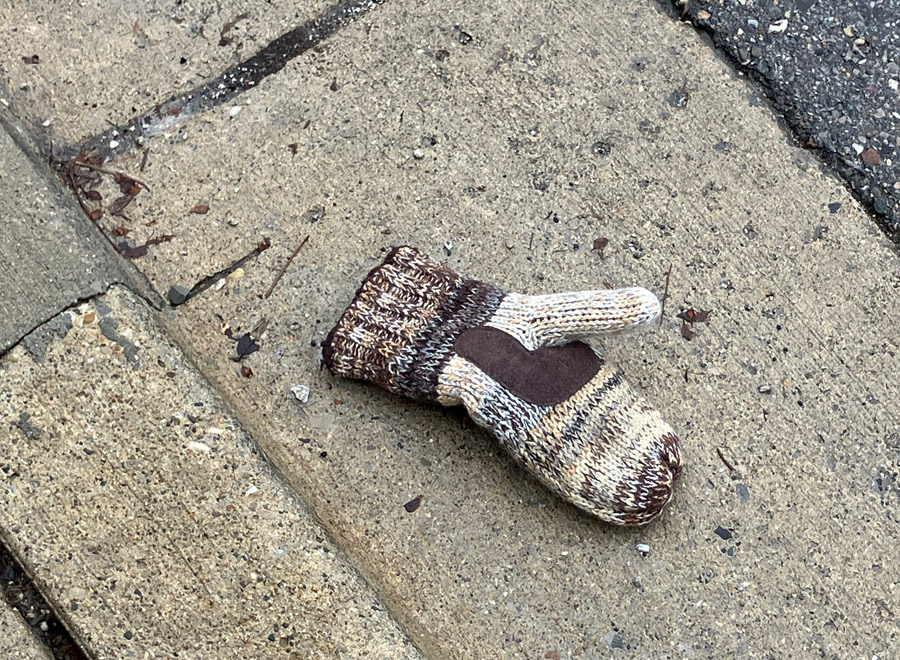
Two hands, one glove
Lost winter items are frequent participants in this double-blind exchange. A single glove has virtually no value to anyone but the one person who still holds its partner; similarly, most people are not comfortable donning the hat of a stranger, no matter how cold the day. The universal lack of interest in adopting a rescue mitten nullifies the impulse to keep, leaving only the impulse to ignore — or to reunite.
For those who take the high road, the impulse is as quixotic as it is unrequitable. On an icy street, there is usually no central authority to which a wayward glove or hat might be brought, and its anonymity and low value make it both impossible and pointless to track down the owner.
But the impulse must be satisfied. And so, we occasionally see a glove or other item that has helpfully been moved to a prominent place, presumably to make it easier for its owner to find it, if he or she returns. It’s all that can be done.
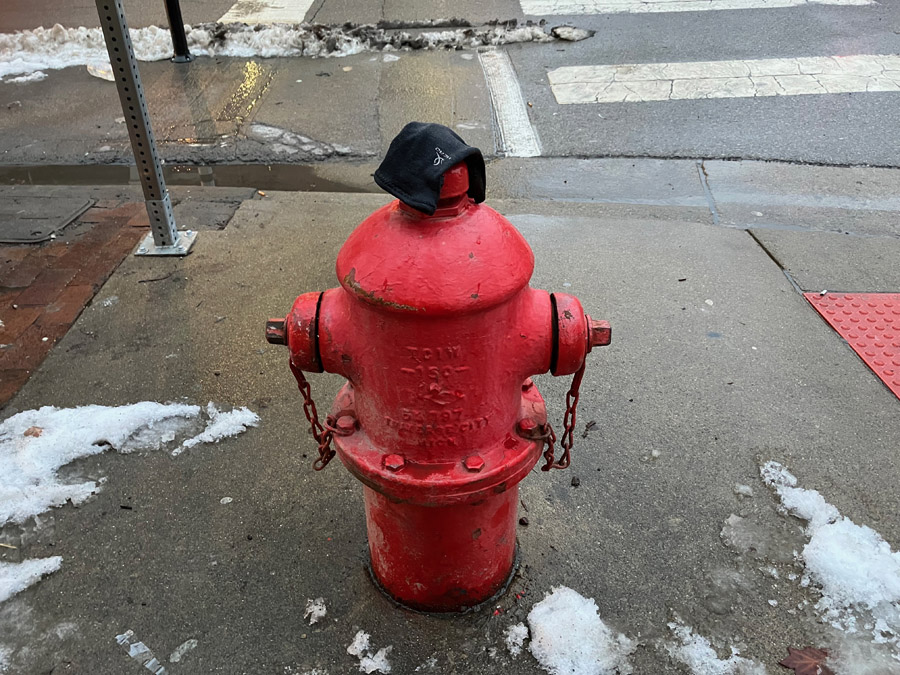
Address unknown
As well-meaning as this gesture seems to be, I’ve often wondered if it’s as helpful as the finder seems to think it is. It seems doubtful that the owner will ever come back, somehow having guessed the exact place where it silently slipped out of a pocket. I’ve seen found items linger where they were placed, for days at a time; in fact, the glove shown above was still adorning the same fire hydrant several days later, though more artfully so; someone had stuck it onto the stem nut, and it was standing up straight as a cockscomb.
But these people might have a point. When snow is on the streets, elevating the item to a higher place is certainly a protective act, if only because it keeps the item out of the slush. But even when there is no slush, it is protective in a much more subtle way: it sends a signal to passersby, showing that although this item is unclaimed, it is not exactly abandoned. By having been removed from the pavement, it takes on a somewhat higher status, as a lost item that has been recognized as such, and is now awaiting its owner. A glove that is poking out of a grimy snowbank or trying to sop up a puddle is definitely on its own, but one that has been caringly placed in a higher spot is not exactly so. Rather than inviting contempt as an unwelcome piece of litter, it still can claim some respect, as an item that has lost its way, and might yet find it again.
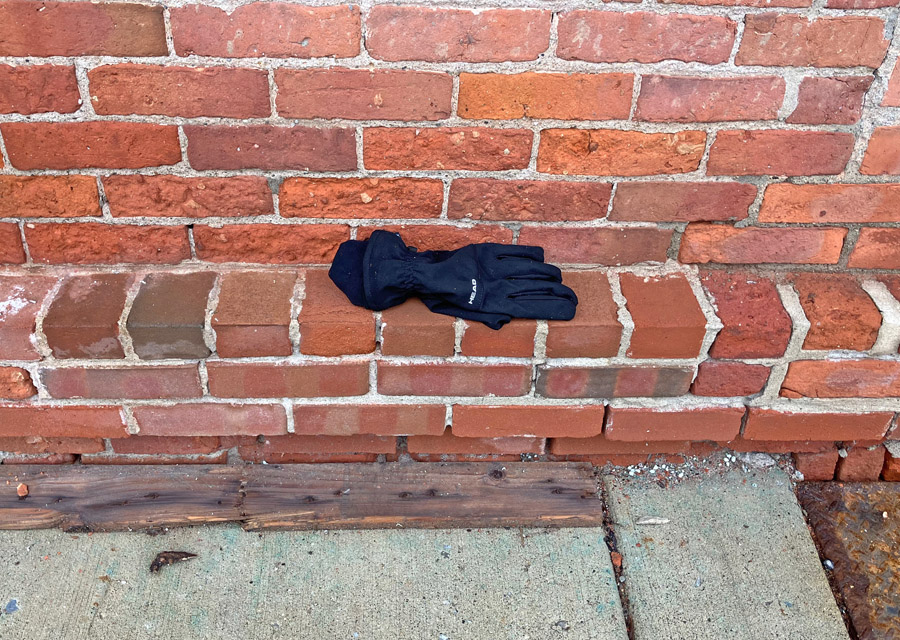
However, it is no longer in the place where it fell. If the owner does come back to look for it, does it help to have it in a place where it could not possibly have dropped?
If, for example, I had lost my visitor’s identification badge within the secure area of a well-guarded government compound (as the person below seems to have done), I would be returning to feverishly scan the pavement, and would never suspect that it might have somehow levitated a full two meters into the boughs of a Lebanese cedar.
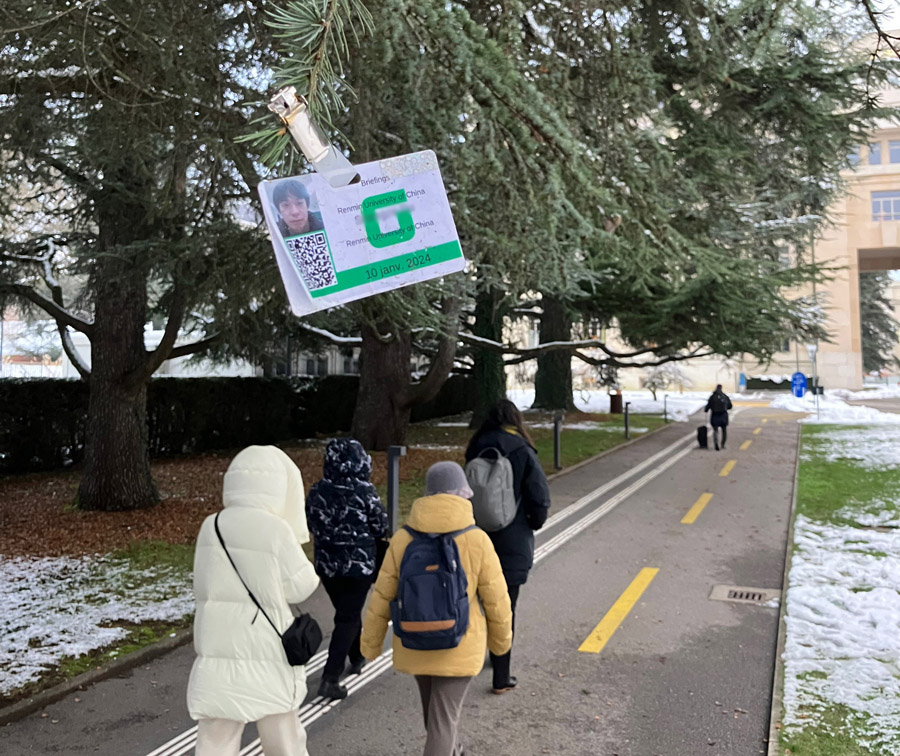
The fact that I noticed it says nothing about whether I would notice it if I was actually looking for it. The fact that I also thought to take a photo attests to the absurdity of its placement. Yet I still recognized it as just another example of a pattern that I have seen many, many times — a lost item that seems to be intentionally eluding its owner, by hiding in plain sight.
A curious phenomenon
After witnessing a lost glove hailing a tram in Switzerland (see title graphic), I became intrigued about the afterlife of lost winter items, and how often they receive the dubious intervention of passersby. On returning home I began keeping an eye out for lost things whenever I happened to think of it. But I wasn’t finding any.
I began to wonder if lost items that have been prominently relocated by another (there really should be a shorter name for this) are examples of one of those phenomena that we’ve seen a million times but, if you go and look for an example, you’ll never find it (there should also be a shorter name for that).
So I decided to begin deliberately repurposing my daily walks to see if this behavior was really as common as I seemed to think it was. The mission: to locate as many lost items as possible amid the rapidly melting snow, and see how many had been intercepted by perceptive passersby.
Let’s go!
Gloves and other winter items were indeed the most common items that were found loitering at a loose end. Whenever my walk took me through a well-traveled neighborhood I had no difficulty finding them. A good portion of them had apparently been rescued and elevated, and seemed to be clinging patiently to the hope that their owner might soon retrace their steps.
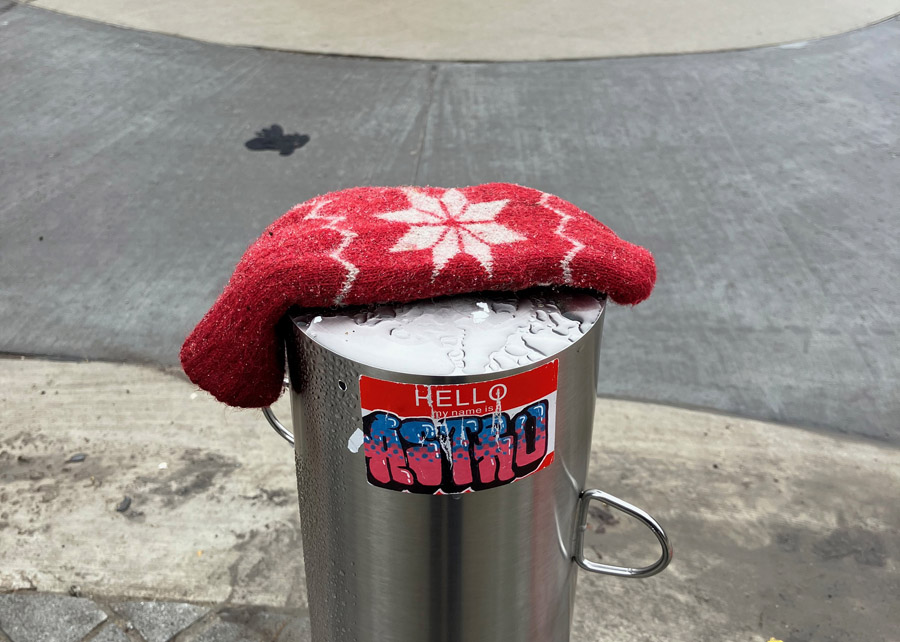
Sometimes the placement was a bit more artful than strictly necessary, making me wonder if it would be recognized as a lost item at all. This hat seems remarkably at home in its new function of warming the top of a parking meter. Four days later, it was still there.
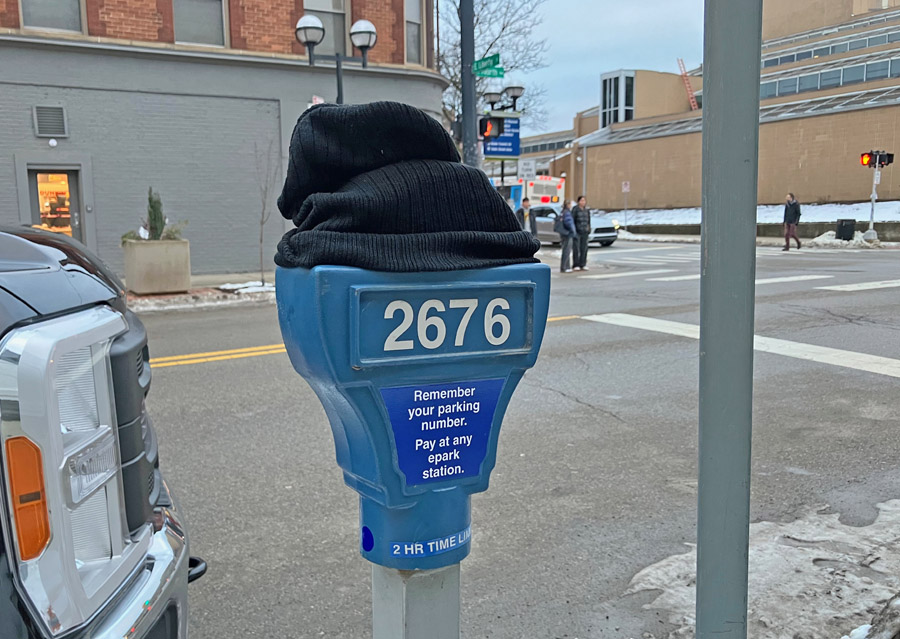
And whether intentionally or not, this dainty three-buttoned glove seemed so content to enjoy its freedom by contemplating a strand of dried foxtail grass, it wasn’t clear whether it was a lost item, or an artwork, or a bit of both.
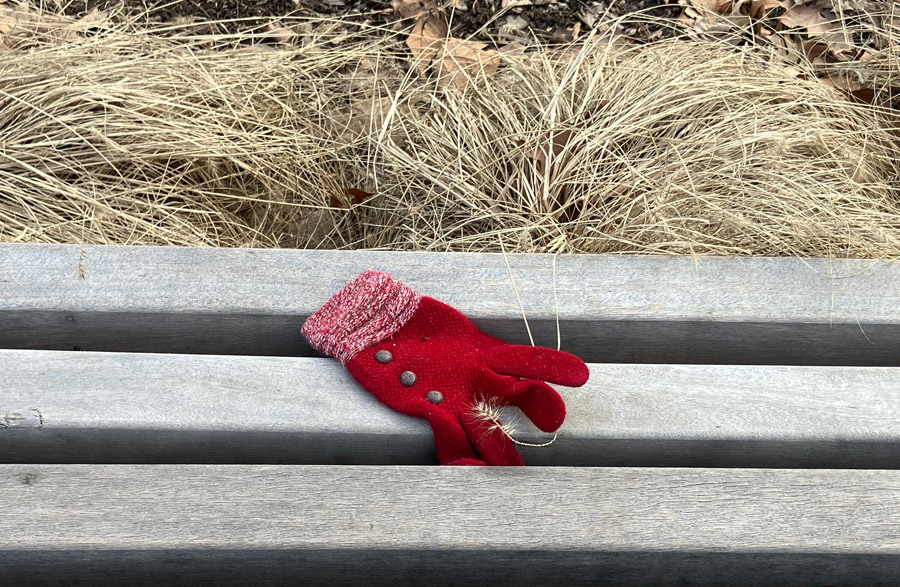
Over the course of these walks I had to repeatedly remind myself to keep an eye not only on the pavement, but also on higher points that a lost item might have been tempted to jump upon. Seemingly any convenient post, ledge, stick, or mysterious utility box is eligible to advertise the discovery of a wayward item, and several of them were so engaged, to varying degrees of effectiveness.
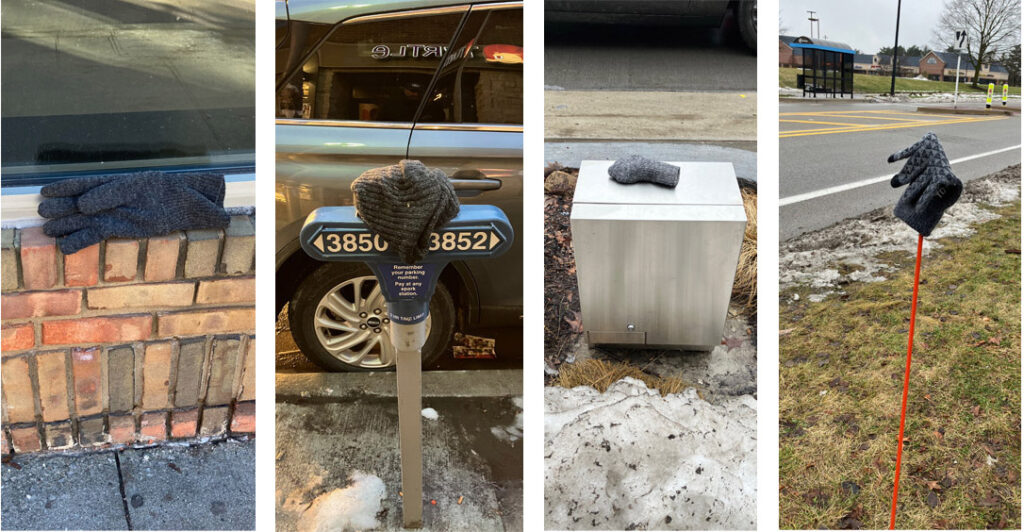
It struck me that this impulse to intercept a lost item for a person we will never meet is something like the diametric opposite of road rage. Equally impulsive and probably as ineffectual, it is the more constructive reaction to one’s anonymity within the crowd. It shows that even as the road has become a battlefield, the sidewalk remains a community — and a spontaneous impulse in one can take an entirely different form in the other.
But it was still completely unclear to me if the good Samaritans of the winter streets are really doing anyone a favor.
The math
So yes, this is quite a common phenomenon. But how common? On one of these walks, I kept a count of what I saw.
Over about three miles, I encountered a total of 18 lost winter items, including several that were too gross to photograph. Of these eighteen, five were in a position where they could not have originally dropped. But the rest had gone unnoticed or ignored, and some were already irretrievably on their way to becoming a part of the winter landscape.
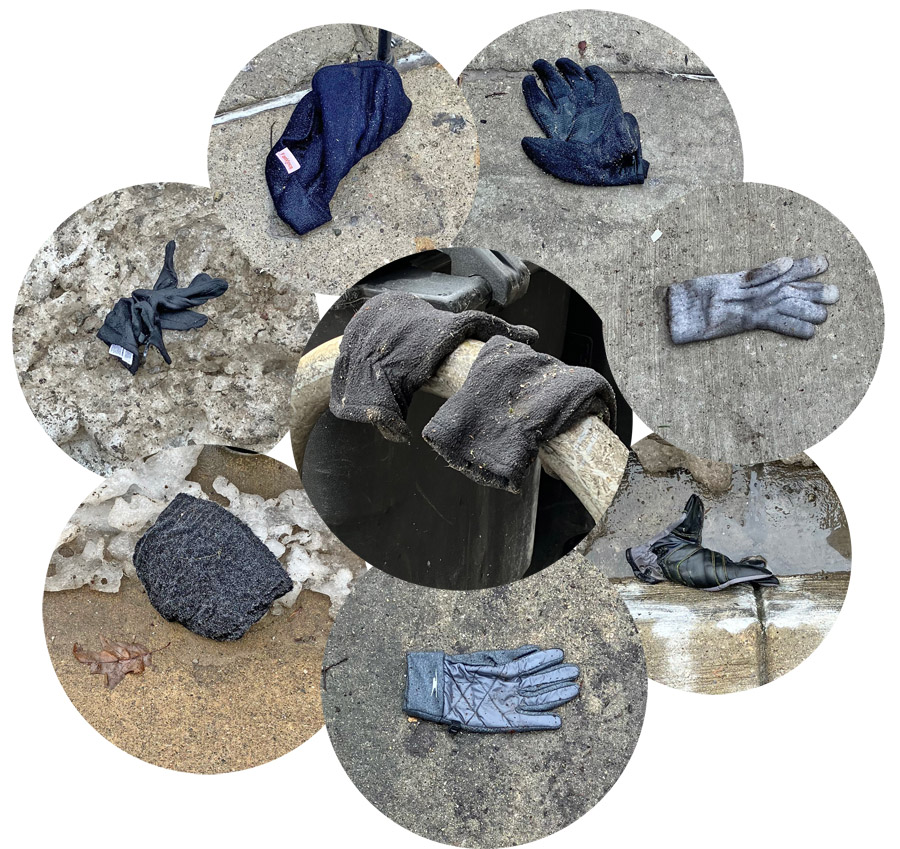
Although my survey was not particularly scientific, it qualifies as anecdotal evidence that if you were to lose a glove or a hat in this neighborhood, it might enjoy a 25 percent chance of being intercepted by a well-meaning passerby and placed somewhere out of the slush.
Still unproven is the significance of this statistic. If we assume that having a lost item picked up and relocated is a good thing (in that the owner may be more likely to recover it), then the interventionists may be having a positive impact. On the other hand, if becoming more prominent means a greater chance of being noticed and discarded, then it’s not such a good thing. Shopkeepers do like to keep their entrances tidy, and may be motivated to remove anything that is out of place. As a case in point, both the black glove and the brown mitten that I photographed on the pavement near the entrance of a grocery store one morning had already disappeared by the afternoon. Rather than being retrieved by their owner, it seems more likely that they disappeared into the garbage bag of the custodian, who was busy emptying the waste cans. A glove or a hat left on the ledge of a window or a nearby fireplug could easily meet the same fate — if it isn’t knocked back to the ground by the wind or a passing pedestrian.
Regardless of which camp you’re in, it would suggest that items made more prominent by this act may be spending less time in the sample population than those that join the slush — meaning that passersby may actually be intercepting lost items even more often than the sample indicates.
So score a point for good intentions, anyway.
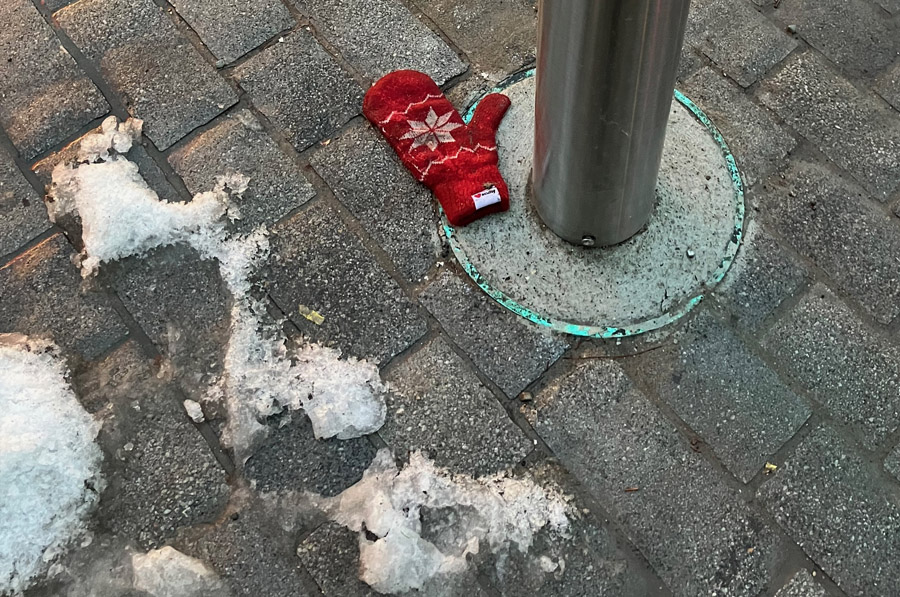
After all the snow had cleared, I took one final walk. It was sunny, but cold enough again for gloves and hats, and I wondered if they were still being lost and intercepted. But there were markedly fewer to be found. On a hike of similar length through the same neighborhood, this time I saw only half as many, and none had been moved to an elevated spot — unless you count the one that was on a park bench contemplating a botany degree, which could go either way.
Just as items are often lost in transitional zones, perhaps it’s also in the transitions between sunny and snowy when this losing-and-finding behavior reaches its peak. Is there something in the soul and spirit of times of transition that brings out the latent Samaritan in some of us?
It’s possible that in this simple courtesy, we are observing human kindness at its most sincere and in its smallest indivisible unit. The value of the item is negligible; the cost of the gesture is similarly so; it has little chance of success, and even less of reward. The best one can hope for is the feeling of having tried to help, or more precisely, of being the one who cared enough to try.
But these same attributes also testify against themselves. With no real effort spent, and no hope of real reward, the finder has no real skin in the game. And as many do-gooders have discovered, sometimes the world just doesn’t want to be saved. The hope that the owner of a lost glove will return in search of their property is most likely a romantic mirage. By the time the second person has found it, the first has already begun rationalizing the loss, and is moving on. The virtual connection has formed, but they are the first to know that the gulf will stubbornly remain.
I suspect this is why some of the items I found seemed to be rather artfully placed. Faced with a gulf that cannot be bridged, perhaps the best reaction is to make the item into an effigy of futility itself. A glove cannot hail a tram, a hat cannot warm a parking meter, and a fireplug cannot grow a rooster’s comb — but by turning a gesture of altruism into a gesture of creativity, we can all have some fun pretending they can.
Article and photos Copyright 2024.
To be notified of new articles, visit https://whatshallweweird.com/subscribe/
